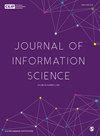图书馆情报学(LIS)团队规模的扩大:越大越好吗?
IF 1.7
4区 管理学
Q3 COMPUTER SCIENCE, INFORMATION SYSTEMS
引用次数: 0
摘要
大型研究团队在当代科学领域的日益普及,促使人们对图书馆情报学领域的团队规模趋势进行了调查。在这项研究中,我们分析了来自微软学术图(MAG)数据集的2000年至2020年间129,560位独特作者撰写的103,299篇LIS出版物。我们从多个维度进行了时间分析,包括期刊四分位数、研究主题和不同影响水平的研究人员。此外,我们采用了两个多元线性回归模型——有和没有作者固定效应——来仔细检查团队规模和发表影响之间的关系。我们的发现揭示了LIS团队规模的持续增长。值得注意的是,高四分位数期刊的出版物往往拥有更大的团队;技术主题出版物的团队规模一般大于理论主题出版物的团队规模;h指数高的研究人员能够组建更大的团队。虽然我们观察到合著论文的平均引用影响高于单作者论文,但在常见的LIS团队规模范围内(3至6名作者),团队扩张对引用增长的总体积极影响并不总是显著的。我们的研究表明,不加选择地扩大团队规模可能不是一个明智的决定。本文章由计算机程序翻译,如有差异,请以英文原文为准。
The expansion of team size in library and information science (LIS): Is bigger always better?
The increasing prevalence of large research teams in contemporary science has prompted an investigation into the trends of team size in library and information science (LIS). In this study, we analysed 103,299 LIS publications written by 129,560 unique authors between 2000 and 2020 sourced from the Microsoft Academic Graph (MAG) data sets. We conducted a temporal analysis from multiple dimensions, including journal quartiles, research topics and researchers with varying impact levels. In addition, we employed two multivariate linear regression models – with and without author fixed effects – to scrutinise the relationship between team size and publication impact. Our findings reveal continuous growth in LIS team size. Notably, publications in higher-quartile journals tend to have larger teams; the team size of technical topic publications is generally larger than that of theoretical topic publications; and researchers with a higher h-index are able to assemble larger teams. Although we observed that co-authored papers have a higher average citation impact than single-authored papers, the overall positive impact of team expansion on citation growth is not always significant within the common LIS team size range (three to six authors). Our research suggests that indiscriminately increasing the size of a team may not be a prudent decision.
求助全文
通过发布文献求助,成功后即可免费获取论文全文。
去求助
来源期刊

Journal of Information Science
工程技术-计算机:信息系统
CiteScore
6.80
自引率
8.30%
发文量
121
审稿时长
4 months
期刊介绍:
The Journal of Information Science is a peer-reviewed international journal of high repute covering topics of interest to all those researching and working in the sciences of information and knowledge management. The Editors welcome material on any aspect of information science theory, policy, application or practice that will advance thinking in the field.
 求助内容:
求助内容: 应助结果提醒方式:
应助结果提醒方式:


